#cloud based lms
Explore tagged Tumblr posts
Text
The Future of Learning: Transforming Philippine Education with Cloud-Based Tech
The future of Philippine education is in the cloud! Discover how cloud-based tech is transforming classrooms and empowering students and institutions nationwide. #DigitalEducation #CloudLearning #EdTech #GoodGuyGadgets #LetsTalkTech
The COVID-19 pandemic accelerated the digital transformation of education, propelling the world into a future where online learning became not just a necessity but a key aspect of modern education. Leveraging Cloud-Based Learning for a Stronger Philippine Education System In the Philippines, this shift unveiled both challenges and opportunities as schools, universities, and other educational…

View On WordPress
#blended learning models#cloud LMS#cloud-based education#educational technology#online education Philippines#Philippine digital learning#Philippine universities
0 notes
Text
Navigating the Future: Choosing the Right Cloud-Based Learning Management System
Build an online course that’s perfect for your company’s transportation training. From aviation training to shipping training our LMS has you covered
https://www.learnright.com/solutions/transportation/
0 notes
Text

Get all the academics and administration operations in order at school using the best LMS for schools such as BMEdulogy. Ensure completion of all the critical processes digitally and save time and resources on paper-based tasks. Maintain all the student, faculty, and staff data on a robust platform and draw useful insights to upgrade the operations. Monitor the finances and attendance easily and let the students track their progress at their fingertips. Keep teachers and students informed about the latest updates and events and allow the parents to monitor the student’s performance.
#bmedulogy#best lms for schools#cloud based learning management system#best learning management system#online class management software#lms for online classes#online classes management system#open source lms#lms platforms#online learning management system#learning management software#learning management system#open source learning management system
0 notes
Text




LES MIS LETTERS IN ADAPTATION - A Rose in Misery, LM 3.8.4 (Les Miserables 1925)
A very young girl was standing in the half-open door. The dormer window of the garret, through which the light fell, was precisely opposite the door, and illuminated the figure with a wan light. She was a frail, emaciated, slender creature; there was nothing but a chemise and a petticoat upon that chilled and shivering nakedness. Her girdle was a string, her head ribbon a string, her pointed shoulders emerged from her chemise, a blond and lymphatic pallor, earth-colored collar-bones, red hands, a half-open and degraded mouth, missing teeth, dull, bold, base eyes; she had the form of a young girl who has missed her youth, and the look of a corrupt old woman; fifty years mingled with fifteen; one of those beings which are both feeble and horrible, and which cause those to shudder whom they do not cause to weep. The most heart-breaking thing of all was, that this young girl had not come into the world to be homely. In her early childhood she must even have been pretty. The grace of her age was still struggling against the hideous, premature decrepitude of debauchery and poverty. The remains of beauty were dying away in that face of sixteen, like the pale sunlight which is extinguished under hideous clouds at dawn on a winter’s day.
#Les Mis#Les Miserables#Les Mis Letters#Eponine#Eponine Thenardier#lesmisedit#lesmiserablesedit#lesmiserables1925edit#pureanonedits#Les Mis Letters in Adaptation#LM 3.8.4#BEST EPONINE ACTUALLY#She's sooooo good.#Les Mis 1925#Les Miserables 1925
171 notes
·
View notes
Text





youtube
Romi conversation AI robot, Mixi, Japan (2021). "Romi is a specialized conversation robot that fits snugly in the palm of your hand. Differing from conventional robots equipped with fixed responses, Romi utilizes our cutting-edge proprietary communication AI to keep conversations going, meaning that you can speak to Romi just like a real human. We developed Romi to provide comfort like a pet and understanding like a family member. Possessing a rich range of emotional expression, Romi can share your happiness, sadness, and anger. Romi is sure to brighten your life with over 100 facial expressions and movement patterns and help you bring out the best of every day with over 100 functions such as alarms and reminders." – Providing space and opportunity for communication with Romi, Mixi.
"First, when a person speaks to Romi, Romi converts the voice data into string data via the Google Cloud Speech API. When this string data is sent to the conversation server, the server constructs the answer as text data and returns it to Romi. Finally, Romi uses text-to-speech to convert text into speech and respond to people. Romi uses generative AI in its conversation server to construct answers to people. However, the generative AI model used by Romi is "in a different direction of development'' from models such as GPT-4 … [where] hallucination becomes a major issue. On the other hand, Shinoda's managers tuned Romi based on the idea that even if there were some mistakes, 'as long as it's fun to talk about and the users laugh, that's fine.' This is one of the reasons why we used Stable LM as the base model for our original AI." – an interview with Harumi Shinoda, Vantage Studio Romi Division Development Group Manager, MIXI's conversation robot "Romi" that heals people, AI tuning that emphasizes fun over accuracy.
8 notes
·
View notes
Text
Top Trends Shaping Classrooms Latest trends in educational technology for personalized learning
latest trends in educational technology for personalized learning is remodeling the panorama of getting to know, shaping how college students and educators engage with content material, and altering the very nature of the instructional enjoy. As we circulate in addition into the twenty first century, numerous tendencies are rising that promise to decorate academic results, customise getting to know, and put together students for a hastily evolving world. This article delves into the current developments in academic technology, examining their implications and potential effect on the future of training.
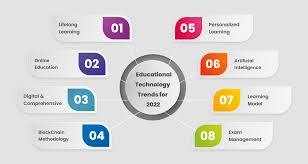
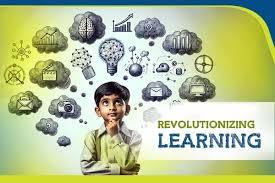
Artificial Intelligence (AI) and Machine Learning
Impact of artificial intelligence on classroom learning experiences and machine gaining knowledge of are revolutionizing schooling by way of enabling more customized and adaptive studying reports. AI-powered systems can analyze pupil performance records to tailor educational content to man or woman wishes. For example, AI can perceive a student’s strengths and weaknesses, supplying customized sporting events and resources to address particular gaps in expertise.
Key Applications
Adaptive Learning Systems
Platforms like DreamBox and Knewton adjust the problem and kind of content based on real-time evaluation of scholar interactions.
Automated Grading
AI can grade assignments and provide instantaneous comments, reducing the administrative burden on educators and letting them recognition greater on interactive coaching.
Virtual Reality (VR) and Augmented Reality (AR)
Virtual Reality (VR) and Augmented Reality (AR) are developing immersive gaining knowledge of environments that could decorate engagement and information. These technologies offer college students the opportunity to discover and engage with content in approaches that conventional strategies can not.
Key Applications
Virtual Field Trips
VR allows college students to go to historic websites, outer space, or maybe microscopic environments with out leaving the classroom. For instance, Google Expeditions gives virtual area trips to numerous global landmarks.
Interactive Simulations
: AR packages like JigSpace permit students to visualise complex ideas, such as the workings of the human frame or mechanical structures, via interactive 3-D fashions.
Gamification
Gamification incorporates recreation design elements into instructional settings to make gaining knowledge of extra enticing and motivating. By integrating factors, badges, leaderboards, and other recreation-like functions, educators can beautify scholar motivation and participation.
Educational Games
Platforms like Kahoot! And Quizizz use game mechanics to make quizzes and evaluation periods extra interactive and competitive.
Game-Based Learning Environments
Tools like Classcraft include function-gambling sport elements to encourage nice behavior and collaboration among students.
Learning Analytics
Learning analytics involves the collection and evaluation of data related to pupil getting to know methods and results. By leveraging data, educators can benefit insights into student overall performance and make knowledgeable selections to enhance teaching strategies and gaining knowledge of environments.
Performance Tracking
Learning management systems (LMS) like Canvas and Blackboard offer analytics dashboards that assist educators monitor student progress and identify trends.
Predictive Analytics
Tools such as Brightspace’s Insights use ancient statistics to expect student performance and perceive those at risk of falling at the back of.
Cloud-Based Learning Platforms
Cloud-primarily based mastering systems provide flexible and scalable answers for handing over educational content material and dealing with classroom sports. These systems facilitate collaboration, useful resource sharing, and get right of entry to to instructional materials from anywhere with a web connection.
Collaborative Tools
Google Classroom and Microsoft Teams for Education provide gear for document sharing, institution work, and communication amongst college students and teachers.
Resource Access: Platforms like Edmodo and Schoology enable college students to access route materials, submit assignments, and interact with friends and instructors on-line.
EdTech for Special Education
Technology is more and more getting used to support students with unique wishes, imparting gear and assets tailored to numerous mastering requirements. Assistive technologies and adaptive mastering equipment are assisting to create more inclusive academic environments.
Text-to-Speech and Speech-to-Text Tools
Tools like Kurzweil 3000 and Dragon NaturallySpeaking assist college students with analyzing and writing problems.
Customized Learning Environments:
Software like ModMath helps college students with dysgraphia by using providing a digital platform for fixing math troubles.
Blockchain for Education
Blockchain generation, recognised more often than not for its use in cryptocurrencies, is beginning to make an impact in education through its ability to securely and transparently manage instructional facts and credentials.
Digital Diplomas and Certificates
Platforms like Learning Machine and the MIT Media Lab are using blockchain to issue and verify virtual diplomas and certificates, lowering fraud and simplifying the credential verification method.
Decentralized Learning Records
: Blockchain can create steady, immutable statistics of scholar achievements and gaining knowledge of pathways, supplying a complete and verifiable educational history.
Personalized Learning
Personalized learning leverages technology to tailor academic stories to the specific needs and options of every student. This technique aims to enhance learning by using accommodating person getting to know styles, paces, and hobbies.
Customized Learning Paths
Platforms like Khan Academy and Coursera provide publications that adapt to the learner’s pace and provide recommendations based totally on progress and hobbies.
Learning Profiles
Tools inclusive of SMART Learning Suite allow teachers to create and track personalized getting to know profiles for every student, facilitating targeted coaching and comments.
Internet of Things (IoT) in Education
The Internet of Things (IoT) connects various devices and sensors to the net, enabling clever lecture rooms wherein bodily items can have interaction with digital structures. This technology has the ability to enhance each coaching and mastering stories.
Smart Classrooms
IoT gadgets like clever whiteboards and related sensors can music classroom situations, along with temperature and lights, and modify them to optimize gaining knowledge of environments.
Interactive Learning Tools
IoT-enabled devices, including linked robots and programmable sensors, offer hands-on learning reviews in subjects like robotics and science.
Mobile Learning
Mobile getting to know, or m-studying, utilizes cellular devices like smartphones and capsules to facilitate getting to know out of doors traditional classroom settings. This fashion helps anytime, everywhere access to educational assets.
Educational Apps
Apps such as Duolingo for language getting to know and Photomath for solving math troubles offer on-the-go gaining knowledge of possibilities.
Flexible Learning Resources
Mobile structures allow students to get right of entry to path materials, participate in discussions, and entire assignments from their devices.
#latest trends in educational technology for personalized learning#Impact of artificial intelligence on classroom learning experiences
2 notes
·
View notes
Note
I would love to know the idea behind you're wip title "LM A harpy"
it stands for ‘little mermaid albedo harpy’, and it’s one of the many ancient fairytale event requests which i never wrote. i put it on the wip list because i do type at it here and there, so it might (might) be posted one day. here’s an extract from the opening:
Once upon a time… There lived a prince in a palace. The prince was renowned for his intelligence and beauty, and many people from all around the kingdom asked for his hand in marriage. However, the prince turned down every request, for he did not return the love that his suitors had for him. This was not because he was cruel, but instead because the prince had a secret: he had no capacity for love, because his heart was made of chalk, and chalk does not beat or love like a real heart does. Nobody knew this besides the prince himself; not even the palace guards knew. The royal palace stood at the base of a mountain. It was the largest mountain in the entire kingdom, snow-capped and lined with forests of evergreen and pine. The mountain was so tall that nobody could ever see its peak, because it was always swallowed up by a blanket of wind and clouds that swirled around where its summit would be. At the top of this mountain, unknown to the prince or his peoples, lived a clan of bird-people. They all had human faces with yellow eyes, but their legs ended in scales and sharp, hooked talons. Feathery wings sprouted from their shoulders, brown and black and speckled with white, and they had voices like a crow’s. They rode like kites on the frostbitten gales surrounding the mountaintop and hunted animals in the snow, and shrieked calls of joy that echoed down the valleys and slopes to the palace below, where they were often mistaken for a bird of prey. In some stories, these people were known as harpies.
4 notes
·
View notes
Text
Read 59 of them. Bolded: have read. Bolded and purple: strongly recommended, I enjoyed these a lot. I actively recommend against reading The Da Vinci Code or Gone With the Wind, and there’s others on the list you definitely don’t need to be going out of your way to read - I think this must be a list of top sellers at some point, not a list based on inherent quality.
1. Pride and Prejudice - Jane Austen
2 Lord of the Rings - J. R. R. Tolkein
3 Jane Eyre – Charlotte Bronte
4 Harry Potter series
5 To Kill a Mockingbird - Harper Lee
6 The Bible
7 Wuthering Heights – Emily Bronte
8 Nineteen Eighty Four – George Orwell
9 His Dark Materials – Philip Pullman
10 Great Expectations – Charles Dickens
11 Little Women – Louisa M Alcott
12 Tess of the D’Urbervilles – Thomas Hardy
13 Catch 22 – Joseph Heller
14 Complete Works of Shakespeare (I’ve read some)
15 Rebecca – Daphne Du Maurier
16 The Hobbit – JRR Tolkien
17 Birdsong – Sebastian Faulks
18 Catcher in the Rye
19 The Time Traveller’s Wife - Audrey Niffeneger
20 Middlemarch – George Eliot
21 Gone With The Wind – Margaret Mitchell
22 The Great Gatsby – F Scott Fitzgerald
23 Bleak House – Charles Dickens
24 War and Peace – Leo Tolstoy
25 The Hitch Hiker’s Guide to the Galaxy – Douglas Adams
26 Brideshead Revisited – Evelyn Waugh
27 Crime and Punishment – Fyodor Dostoyevsky
28 Grapes of Wrath – John Steinbeck
29 Alice in Wonderland – Lewis Carroll
30 The Wind in the Willows – Kenneth Grahame
31 Anna Karenina – Leo Tolstoy
32 David Copperfield – Charles Dickens
33 Chronicles of Narnia – CS Lewis
34 Emma – Jane Austen
35 Persuasion – Jane Austen
36 The Lion, The Witch and The Wardrobe – CS Lewis
37 The Kite Runner - Khaled Hosseini
38 Captain Corelli’s Mandolin - Louis De Bernieres
39 Memoirs of a Geisha – Arthur Golden
40 Winnie the Pooh – AA Milne
41 Animal Farm – George Orwell
42 The Da Vinci Code – Dan Brown
43 One Hundred Years of Solitude – Gabriel Garcia Marquez
44 A Prayer for Owen Meaney – John Irving
45 The Woman in White – Wilkie Collins
46 Anne of Green Gables – LM Montgomery
47 Far From The Madding Crowd – Thomas Hardy
48 The Handmaid’s Tale – Margaret Atwood
49 Lord of the Flies – William Golding
50 Atonement – Ian McEwan
51 Life of Pi – Yann Martel
52 Dune – Frank Herbert
53 Cold Comfort Farm – Stella Gibbons
54 Sense and Sensibility – Jane Austen
55 A Suitable Boy – Vikram Seth
56 The Shadow of the Wind – Carlos Ruiz Zafon
57 A Tale Of Two Cities – Charles Dickens (as a novel, I liked it; as a depiction of the French Revolution, definitely don’t rely on it)
58 Brave New World – Aldous Huxley
59 The Curious Incident of the Dog in the Night-time – Mark Haddon
60 Love In The Time Of Cholera – Gabriel Garcia Marquez
61 Of Mice and Men – John Steinbeck
62 Lolita – Vladimir Nabokov
63 The Secret History – Donna Tartt
64 The Lovely Bones - Alice Sebold
65 Count of Monte Cristo – Alexandre Dumas
66 On The Road – Jack Kerouac
67 Jude the Obscure – Thomas Hardy
68 Bridget Jones’s Diary – Helen Fielding
69 Midnight’s Children – Salman Rushdie
70 Moby Dick – Herman Melville
71 Oliver Twist – Charles Dickens
72 Dracula – Bram Stoker
73 The Secret Garden – Frances Hodgson Burnett
74 Notes From A Small Island – Bill Bryson
75 Ulysses – James Joyce
76 The Bell Jar – Sylvia Plath
77 Swallows and Amazons - Arthur Ransome
78 Germinal – Emile Zola
79 Vanity Fair – William Makepeace Thackeray
80 Possession – AS Byatt
81 A Christmas Carol – Charles Dickens
82 Cloud Atlas – David Mitchel
83 The Color Purple – Alice Walker
84 The Remains of the Day – Kazuo Ishiguro
85 Madame Bovary – Gustave Flaubert
86 A Fine Balance – Rohinton Mistry
87 Charlotte’s Web – EB White
88 The Five People You Meet In Heaven – Mitch Albom
89 Adventures of Sherlock Holmes – Sir Arthur Conan Doyle (I’ve read some of them; can’t say if they’re from this volume specifically, but I’m counting it)
90 The Faraway Tree Collection – Enid Blyton
91 Heart of Darkness – Joseph Conrad
92 The Little Prince – Antoine De Saint-Exupery
93 The Wasp Factory – Iain Banks
94 Watership Down – Richard Adams
95 A Confederacy of Dunces – John Kennedy Toole
96 A Town Like Alice – Nevil Shute
97 The Three Musketeers – Alexandre Dumas
98 Hamlet – William Shakespeare
99 Charlie and the Chocolate Factory – Roald Dahl
100 Les Miserables – Victor Hugo
How many have you read?
The BBC estimates that most people will only read 6 books out of the 100 listed below. Reblog this and bold the titles you’ve read.
1 Pride and Prejudice - Jane Austen 2 Lord of the Rings - J. R. R. Tolkein 3 Jane Eyre – Charlotte Bronte 4 Harry Potter series 5 To Kill a Mockingbird - Harper Lee 6 The Bible 7 Wuthering Heights – Emily Bronte 8 Nineteen Eighty Four – George Orwell 9 His Dark Materials – Philip Pullman 10 Great Expectations – Charles Dickens 11 Little Women – Louisa M Alcott 12 Tess of the D’Urbervilles – Thomas Hardy 13 Catch 22 – Joseph Heller 14 Complete Works of Shakespeare 15 Rebecca – Daphne Du Maurier 16 The Hobbit – JRR Tolkien 17 Birdsong – Sebastian Faulks 18 Catcher in the Rye 19 The Time Traveller’s Wife - Audrey Niffeneger 20 Middlemarch – George Eliot 21 Gone With The Wind – Margaret Mitchell 22 The Great Gatsby – F Scott Fitzgerald 23 Bleak House – Charles Dickens 24 War and Peace – Leo Tolstoy 25 The Hitch Hiker’s Guide to the Galaxy – Douglas Adams 26 Brideshead Revisited – Evelyn Waugh 27 Crime and Punishment – Fyodor Dostoyevsky 28 Grapes of Wrath – John Steinbeck 29 Alice in Wonderland – Lewis Carroll 30 The Wind in the Willows – Kenneth Grahame 31 Anna Karenina – Leo Tolstoy 32 David Copperfield – Charles Dickens 33 Chronicles of Narnia – CS Lewis 34 Emma – Jane Austen 35 Persuasion – Jane Austen 36 The Lion, The Witch and The Wardrobe – CS Lewis 37 The Kite Runner - Khaled Hosseini 38 Captain Corelli’s Mandolin - Louis De Bernieres 39 Memoirs of a Geisha – Arthur Golden 40 Winnie the Pooh – AA Milne 41 Animal Farm – George Orwell 42 The Da Vinci Code – Dan Brown 43 One Hundred Years of Solitude – Gabriel Garcia Marquez 44 A Prayer for Owen Meaney – John Irving 45 The Woman in White – Wilkie Collins 46 Anne of Green Gables – LM Montgomery 47 Far From The Madding Crowd – Thomas Hardy 48 The Handmaid’s Tale – Margaret Atwood 49 Lord of the Flies – William Golding 50 Atonement – Ian McEwan
51 Life of Pi – Yann Martel 52 Dune – Frank Herbert 53 Cold Comfort Farm – Stella Gibbons 54 Sense and Sensibility – Jane Austen 55 A Suitable Boy – Vikram Seth 56 The Shadow of the Wind – Carlos Ruiz Zafon 57 A Tale Of Two Cities – Charles Dickens 58 Brave New World – Aldous Huxley 59 The Curious Incident of the Dog in the Night-time – Mark Haddon 60 Love In The Time Of Cholera – Gabriel Garcia Marquez 61 Of Mice and Men – John Steinbeck 62 Lolita – Vladimir Nabokov 63 The Secret History – Donna Tartt 64 The Lovely Bones - Alice Sebold 65 Count of Monte Cristo – Alexandre Dumas 66 On The Road – Jack Kerouac 67 Jude the Obscure – Thomas Hardy 68 Bridget Jones’s Diary – Helen Fielding 69 Midnight’s Children – Salman Rushdie 70 Moby Dick – Herman Melville 71 Oliver Twist – Charles Dickens 72 Dracula – Bram Stoker 73 The Secret Garden – Frances Hodgson Burnett 74 Notes From A Small Island – Bill Bryson 75 Ulysses – James Joyce 76 The Bell Jar – Sylvia Plath 77 Swallows and Amazons - Arthur Ransome 78 Germinal – Emile Zola 79 Vanity Fair – William Makepeace Thackeray 80 Possession – AS Byatt 81 A Christmas Carol – Charles Dickens 82 Cloud Atlas – David Mitchel 83 The Color Purple – Alice Walker 84 The Remains of the Day – Kazuo Ishiguro 85 Madame Bovary – Gustave Flaubert 86 A Fine Balance – Rohinton Mistry 87 Charlotte’s Web – EB White 88 The Five People You Meet In Heaven – Mitch Albom 89 Adventures of Sherlock Holmes – Sir Arthur Conan Doyle 90 The Faraway Tree Collection – Enid Blyton 91 Heart of Darkness – Joseph Conrad 92 The Little Prince – Antoine De Saint-Exupery 93 The Wasp Factory – Iain Banks 94 Watership Down – Richard Adams 95 A Confederacy of Dunces – John Kennedy Toole 96 A Town Like Alice – Nevil Shute 97 The Three Musketeers – Alexandre Dumas 98 Hamlet – William Shakespeare 99 Charlie and the Chocolate Factory – Roald Dahl 100 Les Miserables – Victor Hugo
73K notes
·
View notes
Text
Transforming Workforce Training with Addsoft's Group System
In today’s fast-paced industrial landscape, workforce training plays a crucial role in ensuring operational efficiency, safety, and compliance. Addsoft Technologies has introduced an innovative Group Training System designed to enhance employee learning experiences through advanced digital solutions.

What is the Group Training System?
The Group Training System by Addsoft Technologies is an interactive, technology-driven training platform tailored for organizations looking to streamline and standardize their training programs. It enables companies to deliver high-quality training sessions to multiple employees simultaneously, ensuring consistent knowledge dissemination and improved retention.
Key Features and Benefits
1. Interactive Learning Modules
The system integrates multimedia content, real-time assessments, and interactive quizzes to make training more engaging and effective. Employees can actively participate in learning, fostering better understanding and skill development.
2. Centralized Training Management
With a cloud-based learning management system (LMS), organizations can efficiently schedule, monitor, and track training progress. This feature ensures compliance with industry regulations and helps businesses maintain comprehensive training records.
3. Customizable Training Programs
The Group Training System allows companies to tailor training modules to their specific industry requirements. Whether it's workplace safety, equipment handling, or compliance training, businesses can customize content to meet their unique needs.
4. Multi-User Accessibility
Unlike traditional training methods, this system supports multiple users at once, making it ideal for large-scale training sessions. Employees can access training materials on-site or remotely, increasing flexibility and convenience.
5. Enhanced Employee Performance and Safety
By providing structured and data-driven training, employees gain the necessary knowledge and skills to perform their tasks efficiently. This reduces workplace risks, enhances productivity, and ensures adherence to safety protocols.
Why Choose Addsoft Technologies?
Addsoft Technologies is a trusted name in delivering cutting-edge training solutions for industries worldwide. With expertise in digital learning platforms and workforce training, their Group Training System is designed to maximize learning outcomes and improve overall organizational performance.
Final Thoughts
Incorporating the Group Training System by Addsoft Technologies into your organization’s training strategy ensures a smarter, more effective, and compliant workforce. As industries evolve, investing in advanced training solutions is the key to staying ahead in safety, efficiency, and employee development.
Looking to transform your workforce training? Explore Addsoft Technologies’ Group Training System today!
#blog#article#news#business#technologies#software#electronic#technology#productivity software#enterprise software
0 notes
Text
Top Benefits of Implementing an Employee Training System in Your Organization
Modern businesses depend fundamentally on employee training systems to reach their organizational goals. Every organization that wants to reach higher productivity and workforce efficiency along with better compliance should implement some kind of structured learning system. Your enterprise LMS system will simplify training procedures so workers can enhance their skills, leading to successful business growth.
Your organization will gain these primary advantages by implementing an employee training system.
1. Improved Employee Performance
The employees demonstrate greater competence and confidence at their work following structured training programs. Updates on the most recent technological breakthroughs are presented, and thereby, it allows the employees to learn new information and hone whatever they already know. The resulting quality work produced with the optimum levels of efficiency leads to good organizational performance.
2. Higher Productivity
The efficient employee training system saves the time of employees figuring out tasks themselves. With streamlined learning, the employees become more proficient faster and improve efficiency and productivity. Enterprise LMS systems can offer on-demand training to employees, thus allowing them to upskill without disrupting their workflow.
3. Improved Employee Retention
It demonstrates to employees that the corporation is concerned with their growth and improvement in their profession. This ends in loyalty, decreases turnover quotes, and reduces the fee of recruiting and onboarding new employees. Organizations that provide employee training systems will receive workers who dedicate themselves to organizational success.
4. Compliance and Risk Minimization
All recent industries must conduct compliance training because it ensures strict regulatory compliance. The structured educational content along with the completion tracking system within employee training systems protects organizations from industry standards violations. This ensures that employees adhere to legal and safety regulations, reducing the risk of non-compliance penalties.
5. Cost-Effective Learning Solution
Traditional training methods cost money and time. The best LMS for small businesses is the less expensive option to be accessed via the digital module, accessed online. Online training presents financial benefits because it helps organizations reduce their expenses related to instructor fees and printed material costs alongside travel expenses.
6. Centralized Learning and Knowledge Retention
A cloud-based learning management system functions as a unified digital storage that enables employees to find appropriate courses at any time. Employee knowledge retention improves because they can access training content whenever needed. The system maintains equal training standards throughout the entire organization.
7. Scalability for Business Growth
The expansion of organizations creates increased demand for training solutions that can be easily scaled. An enterprise LMS system would help an organization train its personnel geographically and across locations with no barriers, but easily with added new courses, content changes, and staff onboarding being carried out uniformly with the learning experience being alike for everyone involved.
8. Customization and Personalization
Employee training systems allow an organization to define the learning path by an employee's job and skill levels. Tailored learning will include more participation by learners and satisfactory outcomes. Furthermore, it enables any enterprise to place its tailor-made eLearning content inside the package. This system enables the corporation to reach its goals, which are defined by its organizational targets.
9. Monitoring And Reporting On Time
Training systems contain analytic and reporting capabilities that allow employers to track employee development and assess their performance. Managers have access to data, which helps them both identify skill deficiencies and evaluate training success so they can use this information to transform their training methods. The automated reporting system creates transparent accountability throughout the workforce.
10. Supports Remote and Hybrid Work Models
Businesses empower workers to maintain ongoing education through employee training systems when they use remote and hybrid work arrangements. By using their digital platforms, workers receive industry-related content with organization guidelines and necessary skills for their roles no matter where they are located.
11. Promotes a Culture of Continuous Learning
An organization that organizes its training system builds a learning-based organizational culture. Employees pursue new learning opportunities because they may continuously access training materials under this system. The work culture serves as an innovative force that enables adaptability and professional development, which helps organizations maintain their position in a dynamic market environment.
12. Supports Leadership Development
Training systems function as essential processes that enable organizations to recognize future leaders and help develop them. The management of an organization delivers leadership training programs to prepare these high-potential employees for management roles. Leadership development provides a constant stream of competent professionals prepared for increased accountability that will help strengthen the longer-term success of the company.
13. Bridges Employee Skills Gaps
The training of employees serves to fill performance gaps across workforce competencies within organizational groups. The implementation of specific learning programs provides staff with essential competencies that improve organizational dependence on external hiring while nurturing internal talent.
Conclusion
An employee training system is an investment in the strategic improvement of the workforce's efficiency, compliance, and business growth. Skills Assurance is one of the leading platforms that streamline workforce management and project compliance, ideal for small businesses or large enterprises seeking a reliable and scalable training solution. The right training system will be the best decision for your company to succeed in the long run.
1 note
·
View note
Text
Loan Management System: Guide to Build a System
Financial institutions are constantly adapting to keep up with the ever-changing needs of their customers in today’s fast-moving digital world. One of the most important areas of this evolution is loan servicing. A lot has changed over the years. The Loan Management Software (LMS), which was once a reliable tool for simplifying the loan process and helping people and businesses achieve their goals, no longer meets the demands of today’s environment. Without an efficient Loan Management System (LMS) in place, many are facing financial setbacks, whether it’s through small personal loans or large corporate financing. In economic development loans are a very important part that gives the money to individual and other business to grow them in there full potential. Nonetheless, efficient management of loans necessitates strong systems to tackle difficult tasks such as loan application, loan approval process, disbursement, repayment and compliance monitoring. This is when a Loan Management System comes into the picture to allow financial institutions for simplifying their operations and delivering better customer experiences.
1.What Is a Loan Management System?
A loan management system allows banks, credit unions, captives, and other lenders to streamline the management of all their lending processes, thus reducing operational (and other) expenses. This advent of digital technology has made it possible for smaller consumer lenders to enter the industry. This technology has allowed many such lenders to identify niches for their portfolios, enabling them to make loans to those lacking significant traditional credit histories without increasing their risk exposure.
When it comes to loan management, systems generally are no longer on-premise solutions, as was the case with legacy lending software and the onsite servers that supported it. Instead of involving massive upfront investments, modern lending platforms use cloud-based servers. This offers lenders numerous benefits, including increased flexibility, scalability, and security, along with enabling easier compliance with regulations like those concerning the security and storage of customer data. Smart automation of processes through artificial intelligence (AI), data analytics featuring machine learning algorithms, almost limitless data storage in the cloud, software apps that improve user experience, and other technologies all have advanced lending software.
Key features of an LMS include:
Loan Origination: Simplifies the borrower application process, credit checks, and underwriting. Automation speeds up approvals and minimizes errors.
Loan Servicing: Manages payments, calculates interest, tracks balances, and handles ongoing loan maintenance after approval.
Loan Accounting: Tracks financial details like interest earned, principal payments, and other loan-related data.
Customer Service: Includes tools for seamless communication between lenders and borrowers.
Reporting and Analytics: Generates insights on loan status, portfolio risk, and performance metrics.
Compliance and Regulation: Ensures all processes adhere to local and international regulations.
Debt Collection: Helps manage delinquent accounts, contact borrowers, and streamline recovery efforts.
2.How to Build a Loan Management System?
Developing a loan management system requires a thoughtful and structured approach. It's about creating a powerful tool that streamlines the lending process, making it more efficient and organized. To get it right, you need to understand the system's building blocks and how they fit together. Choosing the right technology is also crucial. But that's just the starting point. You also need to incorporate essential features, rigorously test the system, and ensure it's properly deployed and maintained. By taking a meticulous and comprehensive approach, you can deliver a reliable loan management solution that truly meets the needs of your users.
Step 1: Understanding the Components and Architecture:
Building a robust loan management system starts with a clear understanding of its core components and architecture.
Front-End User Interface: This is what borrowers and lenders see and interact with. A user-friendly and responsive design is essential.
Back-End Database: This is the system's core, storing all loan data. Data security, efficient retrieval, and scalability are critical.
Modules: These handle different stages of the loan lifecycle:
Loan Origination: Manages the loan application and approval process.
Loan Servicing: Handles ongoing loan management, including payments and adjustments.
Debt Collection: Activated when payments are missed.
Reporting: Provides insights into loan performance and other key metrics.
Data Structure: How data is stored and accessed within the database.
Workflows: Streamlined, often automated processes for handling various loan-related tasks.
Integration Points: Connections with external systems, such as credit bureaus or payment gateways.
As well-designed loan management system improves operational efficiency, enhances user experience, and boosts overall performance for lending institutions.
Step 2: Selecting the Right Technology Stack
Selecting the right technology stack is absolutely critical for a high-performing loan management system. Here's a breakdown of key considerations:
Programming Languages: Common choices include JavaScript, typescript and java, offering robust and scalable solutions.
Web Frameworks: Frameworks like Express, React, flutter and Ruby on Rails provide structure and speed up development.
Databases: GraphQL and PostgreSQL are popular database options, known for their reliability and performance.
Cloud Infrastructure: Utilizing cloud services provides scalability and ensures system reliability. APIs (Application Programming Interfaces): APIs are essential for seamless integration with external systems, like payment gateways or credit bureaus.
Third-Party Services: Integrating third-party services can enhance functionality, adding features like fraud detection or automated reporting. Careful selection of each of these components ensures the loan management system is efficient, effective, and meets the needs of both lenders and borrowers.
Step 3: Implementing Key Features and Functionalities:
A robust loan management system requires key features tailored to specific needs. These include:
Loan Origination: Streamlined processing of loan applications and approvals.
Borrower Management: Comprehensive handling of borrower data and profiles.
Automated Payments: Efficient and automated processing of borrower payments.
Document Management: Organized storage and easy retrieval of loan documents.
Credit Scoring: Integration with credit bureaus for borrower creditworthiness assessment.
Risk Assessment: Tools to evaluate loan risk levels and inform lending decisions.
Crucially, these features must align with the organization's specific loan types and operational requirements. Customization ensures the system effectively supports unique business processes and optimizes loan management.
Step 4: Testing and Quality Assurance
A comprehensive loan management system hinges on key features and functionalities. These often include:
Loan Origination: Efficient processing of loan applications, from submission to approval.
Borrower Information Management: Comprehensive storage and management of borrower data.
Automated Payment Processing: Streamlined handling of borrower payments, including automated reminders and processing.
Document Management: Organized storage and easy retrieval of all loan-related documentation.
Credit Scoring: Integration with credit reporting agencies to assess borrower creditworthiness.
Risk Assessment: Tools and processes to evaluate the risk associated with each loan.
Critically, these features must be tailored to your organization's specific needs and the types of loans you manage. This customization ensures the system effectively supports your unique requirements and operational workflows.
Step 5: Deployment and Maintenance
Once development and testing are complete, the loan management system is ready for deployment. The choice between on-premises (in your own data center) and cloud deployment depends on your organization's needs. After deployment, ongoing maintenance, updates, and monitoring are crucial for the system's long-term success.
Here's a closer look at these key stages:
Deployment Options: On-premises gives you full control, while cloud deployment (using platforms like AWS, Azure, or Google Cloud) reduces infrastructure management.
Maintenance and Support: This includes bug fixes, security updates, and adding new features as needed.
Updates and Monitoring: Regular security patches and performance monitoring ensure the system stays secure and runs smoothly.
Scalability: You'll need to be able to scale the system as your organization grows, whether that means expanding cloud resources or adding hardware to your on-premises setup.
User Training and Support: Proper training and support for users will ensure they can use the system effectively.
Backup and Disaster Recovery: Having solid backup and disaster recovery plans is essential to protect your data in case of an emergency.
Whether you choose on-premises or cloud, careful deployment and maintenance are vital for the system's reliability, security, and adaptability. These efforts ensure the system performs well and meets the evolving needs of your financial institution.
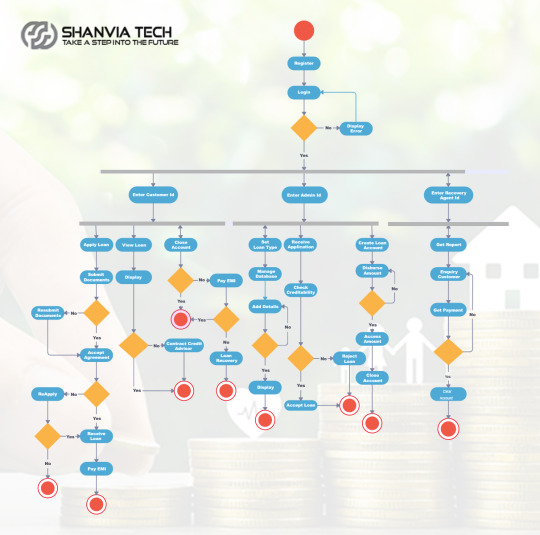
3.Benefits of Loan Management System Software
A Loan Management System (LMS) software provides several benefits including streamlined loan processes, centralized data management, faster loan approvals, reduced operating costs, improved tracking and transparency, enhanced regulatory compliance, and ultimately, increased customer satisfaction by facilitating efficient loan management across all stages, from application to repayment.
Automation Reduces Errors: A major benefit of loan management software is the reduction of human error. Manual loan processing is susceptible to mistakes, including incorrect calculations, data entry errors, and processing delays. Automation minimizes these risks, ensuring accurate loan calculations, proper documentation, and consistent application of lending policies. This leads to improved data integrity, reduced compliance issues, and increased overall efficiency in loan processing.
Optimizing Loan Processes for Time Savings: Loan management software significantly saves time. Automating loan origination, document verification, credit checks, and loan servicing eliminates time-consuming manual tasks. Organized workflows and automated processes speed up loan application processing, reducing turnaround time and boosting operational efficiency. This allows staff to focus on higher-value activities and improves the customer experience.
Real-Time Loan Performance Reporting: Loan management software empowers lenders with digital reporting and analytics, providing valuable insights into loan portfolios and performance. Real-time data analysis enables tracking of key metrics, risk assessment, and informed decision-making. By leveraging these analytics, lenders can identify trends, detect potential defaults, and optimize loan strategies, ultimately improving risk management and profitability.
Competitive Advantage in Lending: Loan management software provides a competitive edge. Enhanced efficiency, faster processing, and accurate decisions enable lenders to offer a superior customer experience. Quick approvals, seamless digital interactions, and personalized loan offerings differentiate lenders, attracting more borrowers and building loyalty.
Optimize Your Lending Processes: Loan management software streamlines lending by automating key tasks. From application intake and credit assessment to document management, payment processing, and collections, automation boosts efficiency, reduces processing times, and ensures timely procedures. This empowers lenders to offer faster, more accurate, and organized services, while also improving internal efficiency and compliance.
4.The Features That Make a Loan Management System Effective
Effective loan management systems streamline the entire lending process. Key features include comprehensive loan origination, flexible loan servicing, integrated document management, real-time reporting and analytics, automated workflows, robust security, seamless integrations, and a user-friendly interface. Prioritizing these features ensures the system meets current needs and supports future growth.
Loan Origination: Loan origination is critical, and a robust system must support it comprehensively. This includes efficient application intake and processing, encompassing borrower data collection, credit checks, and document verification. Automated workflows, regulatory compliance, and a seamless borrower experience are essential.
Loan Servicing: Effective loan servicing is vital for managing loans throughout their lifecycle. A robust loan management system should include
Automated Payment Processing: This streamlines the collection and tracking of borrower payments, reducing manual effort and minimizing errors. It may include features like automated reminders, recurring payment setups, and various payment gateway integrations.
Accurate Interest Calculation: The system must accurately calculate interest accrual based on different interest rate types (fixed, variable), compounding frequencies, and loan terms.
Escrow Management: For loans with escrow accounts (often for property taxes or insurance), the system should manage these funds, including collection, disbursement, and reporting.
Versatile Loan Handling: Lenders often deal with various loan types (e.g., mortgages, personal loans, commercial loans). The system should accommodate these different loan types and their unique characteristics, as well as various repayment plans (e.g., amortizing, balloon payments). It should also allow for account adjustments, such as payment changes or deferrals.
Borrower Portal: A self-service portal empowers borrowers to access their loan information, view payment history, make payments online, download statements, and communicate with the lender. This enhances the borrower experience and reduces the workload for customer service.
3. Unpaid Dues Management: Effective debt collection capabilities are essential for lenders to efficiently manage delinquent loans. A robust loan management system should automate collection processes by sending timely payment reminders, tracking overdue accounts, and generating collection notices. Seamless integration with communication channels such as email, SMS, and phone systems can streamline collection efforts, enhance borrower engagement, and improve overall recovery rates.
4. Data Insights & Reporting: Comprehensive reporting and analytics are essential for lenders to gain valuable insights and optimize loan management. A well-equipped loan management system should include:
Insightful Reporting.
Evaluate loan portfolio performance.
Assess risk exposure and profitability.
Pre-Built Reports & Customizable Dashboards.
Monitor key financial metrics.
Track loan delinquency rates.
Analyze lending trends for strategic decision-making.
Advanced Analytics Capabilities:
Predictive Modeling – Forecast potential loan outcomes and risk scenarios.
Data Visualization – Transform complex data into intuitive, actionable insights.
By leveraging these powerful features, lenders can make data-driven decisions, enhance operational efficiency, and refine their loan strategies for sustained success.
5.How Much Does It Cost to Build a Loan Management System?
Understanding the financial commitment required to develop a loan management system is essential for organizations planning its implementation. Several factors influence development costs, including the system's complexity, technology stack, and level of customization required.
This guide will break down cost estimates based on different types of loan management systems while highlighting key cost drivers. Additionally, we’ll discuss the importance of conducting a Return on Investment (ROI) analysis to assess potential benefits, optimize decision-making, and ensure that investing in a loan management system delivers long-term value.
How Development Costs are Influenced
Factors Affecting the Cost of Developing Loan Management System Software:
Feature Complexity: The more complex the features, the higher the development costs.
Technology Stack: The choice of technologies used for the system can significantly influence development expenses.
Team Expertise: The skill level and experience of the development team play a major role in determining overall costs.
Project Timeline: A shorter project timeline can lead to higher costs, as more resources may be required to meet deadlines.
Customization Needs: Tailoring the software to meet specific business needs can increase development costs.
System Integrations: Integrating the loan management system with existing systems can add to the overall expenses.
Regulatory Compliance: Adhering to industry regulations may require additional investment for compliance measures.
Considering these factors is essential for accurately estimating the total investment required for developing a loan management system.
2. Estimating Costs for Various Types of Loan Management Systems
The cost of developing loan management system software can differ depending on the system's requirements. A basic system with core features and limited customization will generally have a lower development cost. However, a more complex system featuring advanced functionalities, integration options, and regulatory compliance will require a larger investment. Additionally, cloud-based systems may incur extra expenses for hosting and infrastructure.
3. Analyzing Return on Investment (ROI)
While it's important to understand the development costs, evaluating the potential return on investment (ROI) of a loan management system software is equally vital. A thorough ROI analysis should take into account factors like enhanced operational efficiency, time savings, error reduction, better customer experience, and the potential for higher loan volumes and revenue growth. By assessing the long-term advantages and quantifying the ROI, businesses can better justify their investment in the loan management system software.
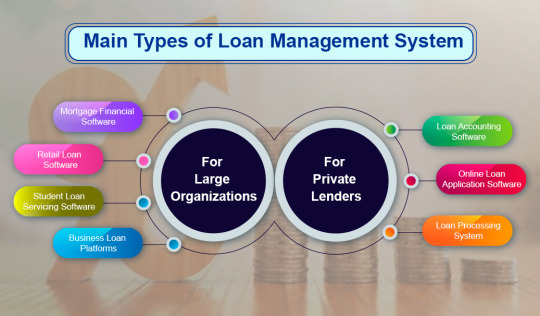
6.Loans Effectively Managed by Loan Management Software
Loan management software is a flexible tool designed to efficiently handle various types of loans. It simplifies the management of loan categories such as personal loans, commercial loans, student loans, syndicated loans, mortgage loans, and payday loans. By streamlining application processes and automating repayment schedules, loan management software equips lenders with the essential tools to manage a wide range of loan portfolios effectively.
Personal Loans: Loan management software adeptly handles personal loans, automating origination, credit checks, document generation, and repayment schedules. It securely stores borrower information for efficient servicing.
Main Characteristics
Automates loan origination
Facilitates credit checks
Generates loan documents
Manages repayment schedules
Securely stores borrower data
2. Commercial Loans
The software simplifies the loan process for small businesses to corporate loans, covering application, credit evaluation, collateral management, and complex repayment structures. Integration with financial analysis tools supports informed lending decisions.
Main Characteristics
Streamlines loan applications.
Assesses creditworthiness.
Tracks collateral.
Manages complex repayment structures.
Integrates with financial analysis tools.
3. Student Loans: Designed specifically for student loans, the software automates application processes, disbursements, balance tracking, and flexible repayment options. It also integrates with educational institutions for seamless billing and efficient servicing.
Main Characteristics
Automates loan applications.
Manages disbursements.
Tracks loan balances.
Offers flexible repayment options.
Facilitates direct billing.
4. Syndicated Loans: The software effectively manages syndicated loans by providing collaboration tools, automating participation agreements, and ensuring precise payment tracking among multiple lenders. Real-time reporting simplifies the management of syndicates.
Main Characteristics
Facilitates collaboration among lenders.
Automates participation agreements.
Tracks payments with accuracy.
Provides real-time reporting.
Simplifies syndicate management.
5. Mortgage Loans: The software automates the origination process, property valuation, title searches, and escrow management for mortgage loans. It efficiently handles amortization, interest, and principal payments to ensure seamless servicing.
Main Characteristics
Automates loan origination.
Manages property valuation.
Handles escrow management.
Calculates payments.
Ensures smooth loan servicing.
6. Payday Loans:
The software efficiently manages payday loans by automating processing, ensuring regulatory compliance, calculating interest and fees, and managing repayment schedules. Integration with payment gateways streamlines the collection process.
Main Characteristics
Automates loan processing.
Ensures compliance with regulations.
Calculates interest and fees.
Manages repayment schedules.
Integrates with payment gateways.
7.Decentralized Finance (DeFi) and Loan Management Systems
The integration of loan management systems with DeFi presents a promising future where lending becomes more democratic, transparent, and accessible to everyone. DeFi-powered loan systems offer a revolutionary approach to loan servicing, free from the constraints of traditional banking models.
Leveraging Blockchain Technology: Blockchain technology in DeFi and loan management brings several key benefits:
Immutable Ledger.
Records all transactions.
Ensures data permanence and protection against tampering.
Transparent Transactions.
Enables participants to view transaction history.
Builds trust and confidence among all parties.
Enhanced Trust & Security.
Attracts both lenders and borrowers.
Reduces fraud and ensures data integrity.
Efficient Loan Management.
Organizes loan systems effectively.
Streamlines loan servicing and enhances reliability.
The use of blockchain in DeFi not only guarantees data integrity but also revolutionizes trust and efficiency in loan management, making it an appealing choice for all involved parties.
2.Integration of DeFi: Integrating DeFi into loan management systems provides lenders with a fresh approach to product development and system management. This DeFi connection enables lenders to create products tailored to the unique needs of individual clients, fostering a more customer-centric lending model. It also offers a platform for more advanced loan servicing software, making the lending process simpler and more efficient.
8.The Future of Loan Management Systems
The future of loan management systems is closely tied to technological advancements in the fast-evolving digital landscape. Key factors to consider include:
Embracing Advanced Technologies: Lenders are progressively incorporating advanced technologies such as AI, machine learning, and blockchain to enhance product offerings and improve customer experiences. These technologies are poised to revolutionize loan management by automating and optimizing processes throughout the loan lifecycle:
AI Integration.
Streamlines origination by automating application processing and credit assessments.
Improves borrower experience with personalized recommendations and instant approvals.
Enhances risk assessment through the analysis of large data sets for more accurate lending decisions.
Machine Learning Benefits.
Predicts default risks by analyzing historical borrower data.
Optimizes loan pricing and terms, boosting profitability.
Automates fraud detection, providing protection against financial crimes.
Blockchain’s Role.
Establishes an immutable ledger for transparent and secure transaction records.
Builds trust and reduces fraud in loan management processes.
Simplifies complex tasks like syndicated loans by enabling efficient collaboration.
The adoption of these technologies marks a major shift in the lending industry, fostering greater efficiency, trust, and innovation throughout the loan management process.
2.Emphasis on End-to-End Loan Servicing Software: As businesses pursue digital transformation, there is a growing emphasis on developing robust loan servicing software. A progressive loan management system prioritizes key features such as AI-driven decision-making, seamless automation, and intuitive user interfaces. Together, these elements minimize the need for manual inputs, enhance accuracy, and streamline loan servicing, ensuring that processes meet the dynamic needs of today’s financial services landscape.
3.Integration of Data Analytics in Loan Management
The future of loan management clearly indicates a growing dependence on data analytics. In today’s digital age, data has become an invaluable asset for lenders. Integrating a loan management system with data analytics enables businesses to embrace data-driven decision-making. This allows for a deeper understanding of market trends, the ability to predict customer behavior, and the optimization of product development processes, ensuring that businesses remain adaptable and responsive to changing market demands.
4.Growth of Mobile App Development in Lending
The financial landscape embraces digitization, it significantly impacts how lenders operate and serve their customers. One noticeable shift is the increasing role of mobile platforms in loan management:
Emerging Trend: The demand for mobile app development in loan management is growing rapidly.
Digital Transformation: As lending processes become digital, customers are seeking mobile-responsive and user-friendly loan servicing solutions.
Competitive Advantage: Lenders are expected to invest heavily in app development to meet customer expectations and stay competitive.
Customer-Centric Focus: Mobile apps provide convenience, accessibility, and improved user experiences, aligning with the changing preferences of borrowers.
9.Reasons to Choose Core Devs for Your Loan Management System Solutions
Exceptional Expertise: At Core Devs, we offer unmatched expertise in developing efficient and robust loan management systems. Our team of skilled developers combines in-depth knowledge of the financial sector with technical excellence, ensuring that your system aligns with the complexities of lending operations and regulatory compliance. With a proven track record of successful projects, Core Devs is more than just a service provider – we’re a strategic partner committed to making your loan management system a key asset that drives your business forward.
Advanced Technology Solutions: In today’s fast-paced digital world, staying ahead of technological trends is essential. At Core Devs, we continuously integrate the latest innovations, such as AI, blockchain, and data analytics, into our loan management solutions. We ensure that your system is not only up-to-date but also ready for future market demands. By partnering with Core Devs, you future-proof your system, keeping it adaptable and competitive in an ever-evolving landscape. Our focus on technological excellence ensures you’re always ahead of the curve.
Tailored Customization: We understand that every business has unique requirements. At Core Devs, we specialize in tailoring loan management systems to meet your specific needs, whether you manage personal, commercial, or specialized loans. Our solutions are designed to integrate seamlessly with your business processes, making them as efficient as possible. When you work with us, you get a partner who understands your unique challenges and objectives, and we craft solutions that are perfectly suited to your organization.
Robust Reliability and Security: In the world of financial technology, security and reliability are non-negotiable. Core Devs prioritizes these aspects, implementing robust security protocols and data encryption to protect both your data and your clients’ information. With us, you can rest easy knowing that your system is secure and reliable. Our stringent security measures protect sensitive data, while our unwavering commitment to reliability ensures that your loan management system is always up and running when you need it.
Outstanding User Experience: User experience is a critical factor in today’s digital landscape. At Core Devs, we design intuitive, user-friendly interfaces that allow both your team and clients to navigate the system effortlessly. Our focus on simplicity and ease of use boosts productivity and enhances customer satisfaction. By choosing Core Devs, you choose a partner who understands the importance of a seamless user experience, which ultimately leads to greater efficiency, customer loyalty, and a stronger reputation for your business.
10.Final Thoughts
Implementing a reliable loan management system is essential for lenders in today’s digital age, where the financial sector is undergoing significant transformation. By automating loan processes, reducing human errors, and leveraging analytics for valuable insights, loan management system software allows lenders to optimize their operations and deliver better services to borrowers.
The advantages of streamlined lending processes, increased efficiency, and enhanced risk management make loan management systems a pivotal tool in the industry. Adopting this technology helps lenders remain competitive, foster growth, and successfully navigate the ever-changing lending landscape.
For more information about their services and to explore how they can assist your business, visit their official website at https://www.shanviatech.com/
0 notes
Text
Top Trends in Educational Technology to Watch in 2025

The education app development industry is undergoing a significant transformation driven by advancements in emerging trends in educational technology.
From AI-powered learning platforms to immersive digital experiences, the integration of new technology in education is creating a more engaging and personalized learning environment.
As we step into 2025, it's essential for educators, institutions, and learners to keep pace with the latest EdTech trends shaping the future of learning. In the article, you will explore the top trends in educational technology to watch in 2025 that will redefine education in the coming years.
AI and Machine Learning in Education
Artificial Intelligence (AI) and Machine Learning (ML) are revolutionizing education by providing adaptive and personalized learning experiences. These education app development technology trends enable real-time assessment, intelligent tutoring, and automated administrative tasks, making learning more effective and data-driven. AI-powered emerging learning technologies help identify student progress, offer customized learning paths, and improve knowledge support.
Blockchain for Secure Credentialing
Blockchain technology is emerging as a new educational technology for credential verification and academic record security. Higher education technology trends are using blockchain for tamper-proof digital transcripts, decentralized credentialing, and fraud prevention. Employers and academic institutions can access verifiable records, improving transparency in education verification.
Virtual and Augmented Reality for Immersive Learning
Immersive education technologies like virtual reality (VR) and augmented reality (AR) are enhancing digital learning experiences. These emerging technology in education trends allow students to explore historical sites, conduct virtual science experiments, and engage in interactive simulations. Such new learning technologies improve student engagement and understanding through real-world applications.
Gamification and Interactive Learning
Gamification is among the top trends in educational technology to watch in 2025, transforming traditional learning into an engaging experience. By incorporating game elements like leaderboards, challenges, and rewards, new tech learning makes education fun and interactive. This trend boosts motivation, participation, and knowledge retention, especially for younger learners.
Adaptive Learning Platforms
Adaptive learning uses AI-driven analytics to customize learning content based on individual student performance. This new educational technology ensures that students receive content customized to their abilities, promoting a more effective learning process. These education technology trends enhance accessibility and efficiency by addressing diverse learning needs.
Cloud-Based Learning Management Systems (LMS)
Cloud-based learning management systems (LMS) are among the most impactful technology trends in education, offering remote access to educational resources. These current educational technology trends support online learning, collaboration, and integration with various digital tools. Cloud LMS solutions provide flexibility for institutions, educators, and students worldwide.
Advancements in Learning Management Systems
Modern LMS platforms are evolving to include AI-driven automation, gamification, and data analytics for a more personalized learning experience. These emerging learning technologies allow institutions to streamline administrative tasks, monitor student progress, and deliver engaging content efficiently. The integration of new features in LMS platforms is making learning more accessible and interactive.
5G and Enhanced Internet Connectivity
The rollout of 5G networks is set to revolutionize digital education by providing high-speed internet access. Emerging technology in education, like 5G, enhances real-time collaboration, video-based learning, and perfect access to cloud-based resources. This trend ensures that students and teachers can interact without connectivity issues, improving online learning quality.
Cybersecurity and Data Privacy in EdTech
With the increasing adoption of educational technology and new trends, safeguarding student and institutional data has become important. Schools and universities are implementing advanced cybersecurity measures, including encryption and multi-factor authentication, to protect sensitive information. Compliance with global privacy regulations ensures secure data management in new learning technologies.
Microlearning and Bite-Sized Education
Microlearning is one of the latest EdTech trends, where educational content is delivered in small, focused segments. This method supports corporate training, skill-based learning, and mobile education by offering bite-sized information that enhances engagement and support. The adoption of new EdTech learning techniques is making education more flexible and accessible.
Conclusion
The top trends in educational technology are driving innovation in learning methods and making education more interactive, accessible, and personalized. As educators and institutions embrace these new trends in educational technology, they must use custom AI solutions and digital tools to improve learning outcomes. Staying ahead in technology trends in education will ensure a future-ready education system in 2025 and beyond.
0 notes
Text

Upgrade the productivity of your tutors, students, and staff by integrating a fully-featured platform to simplify all processes. Enable students to leverage a fully-digitized platform to access their courses, learning materials, and other relevant data. Reduce the need for paperwork and manual tasks to manage data and depend on comprehensive reports and data-driven analysis to improve your education delivery. Adopt the best learning management system and ensure a competent learning environment.
#online class management software#lms for online classes#best lms for schools#online classes management system#cloud based learning management system#cloud learning management system#best learning management system software#best learning management software#best lms software#open source learning management system#open source lms#online learning management system#lms system software#lms platforms#learning management system#lms software
0 notes
Text
The Secret to Faster, More Affordable Learning Programs
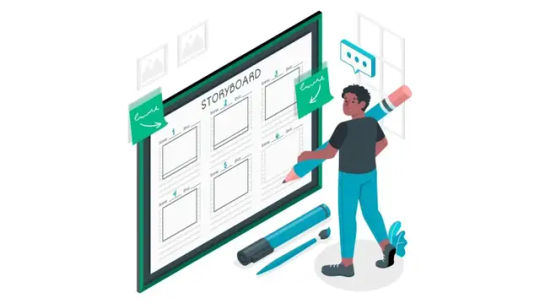
Adaptive microlearning is revolutionizing the landscape of employee training by offering personalized, efficient, and engaging learning experiences. By leveraging adaptive learning technology, organizations can tailor training programs to meet individual needs, thereby enhancing knowledge retention and overall performance. This article delves into the concept of adaptive microlearning, its benefits, and how it integrates with various adaptive learning tools and platforms to optimize workforce development.
Understanding Adaptive Learning
Adaptive learning is an educational approach that utilizes technology to customize learning experiences based on individual learner's strengths, weaknesses, and preferences. By analyzing data on a learner's performance, adaptive learning systems adjust content in real-time to address specific needs, ensuring a more effective learning journey. This method contrasts with traditional one-size-fits-all training programs, offering a more personalized pathway to knowledge acquisition.
docebo.com
Microlearning involves delivering content in small, manageable segments, allowing learners to absorb information at their own pace. When combined with adaptive learning principles, microlearning becomes even more powerful. Adaptive microlearning tailors these bite-sized lessons to the individual's current knowledge level and learning style, enhancing engagement and retention. This approach is particularly beneficial for employees who need to balance training with daily responsibilities, as it provides flexibility and targeted learning opportunities.
Benefits of Adaptive Microlearning in Employee Training
Personalized Learning Paths: Adaptive microlearning creates customized training modules that cater to the unique needs of each employee, addressing specific knowledge gaps and reinforcing strengths.
Increased Engagement: By delivering content that is relevant and appropriately challenging, adaptive microlearning keeps learners engaged, reducing the likelihood of cognitive overload.
Improved Knowledge Retention: The combination of adaptive learning and microlearning ensures that information is presented in a way that aligns with the learner's cognitive processes, enhancing memory retention.
Time and Cost Efficiency: Organizations can save time and resources by focusing training efforts on areas where employees need the most development, rather than employing a blanket training approach.
Scalability: Adaptive microlearning platforms can easily be scaled to accommodate a growing workforce, ensuring consistent training quality across the organization.
Integrating Adaptive Learning Technology into Training Programs
To effectively implement adaptive microlearning, organizations should consider the following steps:
Select Appropriate Adaptive Learning Software: Choose platforms that offer adaptive learning capabilities, such as personalized content delivery and real-time performance analytics. Examples include Area9 Lyceum and other leading adaptive learning platforms.
Develop Modular Content: Create training materials in small, focused segments that can be tailored to different learning paths.
Utilize Adaptive Learning Tools: Incorporate tools that assess learner performance and adjust content dynamically to meet individual needs.
Implement an Adaptive Learning LMS: Leverage a Learning Management System (LMS) that supports adaptive learning functionalities to manage and deliver personalized training programs.
Monitor and Iterate: Continuously analyze learner data to refine and improve training content and delivery methods.
Adaptive Learning Software Tools and Platforms
Several adaptive learning software tools and platforms can facilitate the implementation of adaptive microlearning:
Area9 Lyceum: Offers a cloud-based adaptive learning platform that personalizes content delivery to enhance learning efficiency.
SAP Litmos: Provides a modern LMS that supports adaptive learning and microlearning, enabling efficient workforce training.
Whatfix: An adaptive learning platform that integrates with various LMS and digital adoption platforms to deliver personalized learning experiences.
Adaptive Learning Apps for On-the-Go Training
In today's fast-paced work environment, mobile accessibility is crucial. Adaptive learning apps allow employees to engage in training anytime, anywhere:
Duolingo: An example of an adaptive learning app that personalizes language learning experiences based on user performance.
Khan Academy: Offers personalized learning dashboards and adaptive exercises to help learners study at their own pace.
Implementing Adaptive Microlearning for Frontline Workers
Frontline workers often face unique challenges that make traditional training methods less effective. Adaptive microlearning addresses these challenges by providing:
Flexible Learning Schedules: Allows employees to engage in training during downtime, without disrupting their work routines.
Relevant Content: Delivers training materials that are directly applicable to daily tasks, enhancing the practicality of learning.
Immediate Feedback: Provides real-time assessments and feedback, enabling workers to correct mistakes and reinforce learning promptly.
Case Study: Laing O'Rourke's Training Transformation
Laing O'Rourke, a prominent construction company, restructured its staff training programs by adopting contemporary and accessible formats inspired by social media platforms like Instagram and TikTok. Partnering with SAP, the company aimed to address common issues with traditional training modules, such as their cumbersome nature and low retention rates. The shift to “bite-sized” courses significantly improved learning outcomes and engagement among its 5,500 employees.
Future Trends in Adaptive Microlearning
As technology continues to evolve, adaptive microlearning is poised to incorporate advanced features such as:
Artificial Intelligence (AI): Enhances the ability to analyze learner data and deliver highly personalized content.
#Adaptive Microlearning#what is adaptive learning#adaptive learning software#adaptive learning software tools#adaptive learning tools#adaptive learning technology#adaptive learning lms#adaptive online learning#adaptive learning apps#LmsTraining#training individual#in work training#employee training timeline#learning initiatives#frontline learning#on a job training
0 notes
Text
7 Best Dropbox Plugins for WordPress for 2024
Dropbox is one of the most common free cloud storage offerings. It functions very well as a secure platform for storing your WordPress backups, media files, and vital documents together. No matter the device or your location, your files are always safe with cloud storage. Dropbox let you take advantage of several benefits that can greatly amplify your website's performance, functionality, and safety.
A major reason to implement a Dropbox plugins for WordPress is the consistent approach it delivers save hosting space and manage files on cloud . The rise in the file size of your website means that the number of media files, documents, and other digital assets you have to observe increases over time. Dropbox integration for WordPress provides a feature-rich and efficient solution that improves your website experience.
Why Use Dropbox In WordPress
Dropbox WordPress Plugin allows you on your WordPress site to scale up storage capability incrementally with no need to make physical changes to your hosting. The key advantage also consist in security. Not only that, Dropbox and similar cloud storage services offer better security than traditional computers but also include encryption, secure transfer, and constant security audits for your data.
By storing files on Dropbox you contribute to relieving the pressure on the hosting server enhanced loading time and allow your web site to how in server resources for fast page downloads.
Popular plugins For Dropbox Integrations with WordPress
Integrate Dropbox
Updraft Plus
WP Media Folder
WooCommerce Dropbox
Dropr
Zapier
Out-of-the-Box
Top Reasons to Choose Integrate Dropbox over competitors
Conclusion
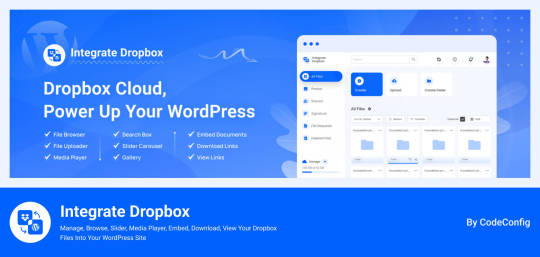
Integrate Dropbox free Dropbox plugins for WordPress, but we do offer premium plan in you need more advanced features from us has several compelling reasons. It offers seamless allowing users to access Dropbox files directly within the WordPress Media Library, Users can upload and download files directly from the WordPress dashboard, with automatic syncing to their Dropbox account.
Search function for Dropbox files and folders within the WordPress dashboard, enabling users to generate shortcodes for frontend display, complete with live search and thumbnail previews.
Price: Free for the base plugin, This plugin has Premium Plan
Key Features
✅ User-Specific Folders: Set up folders specific to individual users. ✅ Auto Sync/Update: Automatically (1-3 mins) sync and update new images to web pages. ✅ Media Library Integration: Seamlessly integrates with WordPress media library. ✅ Elementor Widgets: Offers custom widgets for Elementor builder. ✅ Classic & Gutenberg Editor Support: Compatible with both Classic and Block (Gutenberg) editors. ✅ Folder & File Management: Create, upload, and sync your account. ✅ Shortcode Builder: Easily generate shortcodes for custom functionality. ✅ WooCommerce Support: Works with WooCommerce for downloadable products. ✅ Slider & Carousel: Includes slider carousel for better media display. ✅ File Browser: Allows easy navigation of folders. ✅ Gallery & Media Player: Displays media in galleries and supports playback. ✅ Embed, Download, & View Links: Share using embed codes, download, and view links. ✅ File Search: Quickly search files and folders. ✅ LMS Integration: Compatible with MasterStudy LMS and Tutor LMS.
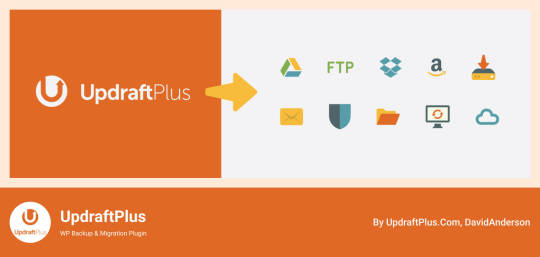
UpdraftPlus functions as a leading WordPress plugin that simplifies how to back up and restore items. Dropping in Dropbox allows users to safely and effortlessly save website backups in a cloud environment. This plugin has embodied excellence in feature delivery, especially with the functionality to make automated backup schedules that simplify recovery from any moment while also giving incremental backup options which only save modifications made since the last full backup, consequently reducing both space and resource needs. Also, UpdraftPlus guarantees that backups are encrypted before they go to Dropbox, adding an additional level of security.
Price: Free for the base plugin, This plugin has Premium Plan
https://codeconfig.dev/wp-content/uploads/2024/09/Plugin-For-WordPress-WP-Media-Folder.jpg
WP Media Folder ties your WordPress media library to Dropbox, delivering you a centralized control experience. From the WordPress dashboard, this tool provides direct means to manage and organize your Dropbox media. The user interface akin to that found on desktops makes it easy to use. The cooperation between Dropbox and WordPress reflects that all changes or updates are reachable on both platforms at each moment. With features for advanced media management such as the creation of galleries from Dropbox images, WP Media Folder serves as an efficient method for managing website media.
Price: This plugin has Premium Plan
WooCommerce Dropbox
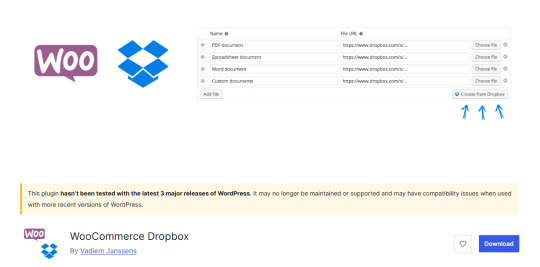
WooCommerce Dropbox brings a way for store owners to connect their digital goods to files already in Dropbox. WooCommerce Dropbox serves to increase the capabilities and usefulness of the e-commerce platform besides ensuring the customers get their products, especially the digital ones, on easily and on time. This setup really helps those selling digital items like software music or videos.
Shoppers get fast and simple downloads without slowing the website down. Using less server effort helps the site stay strong when many people visit. WooCommerce Dropbox plugin changes the usability of downloadable products as it is connected with Dropbox storage answers. This integration enables the e-commerce site owners to be able to host their downloadable content on Dropbox so that they can conserved server space and make their customers gain faster access to their downloads.
Price: Free for the base plugin
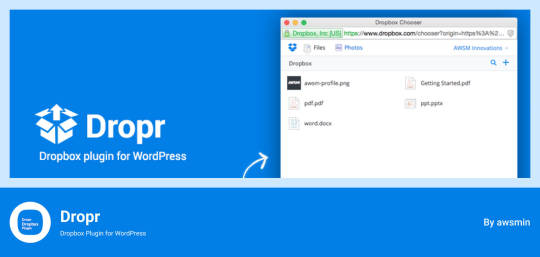
Dropr makes it straightforward to connect Dropbox with your WordPress site. By setting Dropbox as the primary storage for media files, it ensures that all uploads are directly stored in Dropbox, thus freeing up local storage space on the server. Dropr is the cool solution to share Dropbox files as your WordPress media library and embed them in your posts. When it comes to uploading images, videos or documents to your site using Dropr is as easy as working with local files.
This integration proves to be the most advantageous for sites containing a lot of posts and other resources, that would need constant updates and availability of different types of media. With help of Dropr ordinary file transfers take less time and you are able to deliver fresh and active contents for your site all the time.
Price: Free for the base plugin, This plugin has Premium Plan
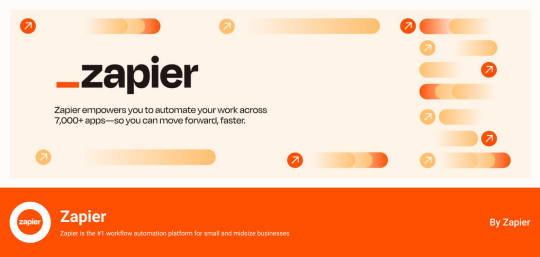
Zapier get expanded by WordPress and Dropbox to perform processes connecting the two applications. While they are not regularly considered as plugins, Zapier can interconnect these platforms and create complex automated workflows which can then increase efficiency and cooperation. For example, when you need the content to be posted on your WordPress site and files are included in the Dropbox, one can set a Zap to accomplish this duty. It is especially helpful for teams that can get overwhelmed when they need a constantly updated and efficient web-based operations dashboard.
Price: Free for the base plugin, This plugin has Premium Plan
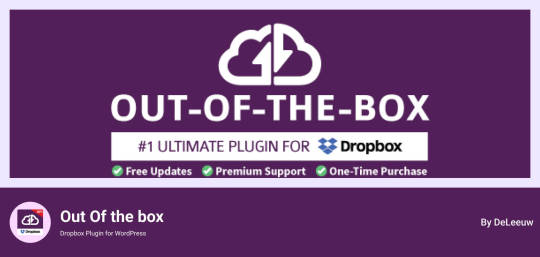
Out of the box provides a new way of handling Dropbox files by integrating it within the WordPress environment. Its integrates your Dropbox media into your WordPress Website and dragging and dropping of the contents into your content is possible in real time. Its allowing for a seamless user interface when dealing with content on WordPress platforms.
Price: This plugin has Premium Plan
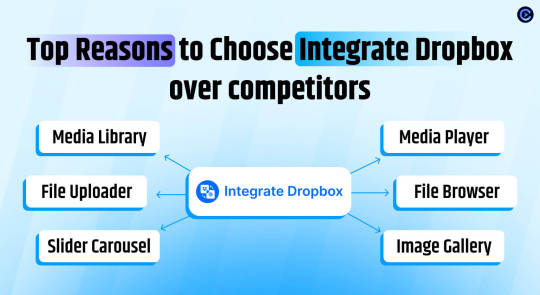
Integrate Dropbox Free dropbox plugins for WordPress makes it easy to link your WordPress site to the Dropbox account and it is the best tool when it comes to organizing files. These are particularly useful to site owners with frequently updating content on the web and requires a single platform to manage it. This way, Integrate Dropbox helps users avoid numerous difficulties connected with files synchronization and access with the help of WordPress dashboard only.
The File Browser provides a web-based interface for convenient access and management of Dropbox files from any device. The Media Player allows users to play Dropbox media files using a customizable player on WordPress site. Users can easily create and name unlimited shortcodes When buy premium for integrating content anywhere on the website, compatible with popular themes.
These features collectively enhance usability, integration, and media management, making the "Integrate Dropbox" plugin a strong choice for WordPress users.
🧩 RICH INTEGRATION WITH POPULAR PLUGINS
▶️ Media Library Integration Simply use your Dropbox files from WordPress Media library and add the images in pages and posts as media, featured images, galleries, etc. Get the Image from Dropbox directly.
🔀 Gutenberg Block Editor Integration Integrate Dropbox allows 7 blocks for using File Browser, Gallery, Media Player, Slider, View, and Download link modules in the Gutenberg editor.
🔀 Elementor Website Builder Integration This plugin integrates with Elementor, offering over 7 widgets for File Browser, Gallery, Media Player, Slider, View, and Download link modules.
Conclusion
Integration of Dropbox on WordPress has turned into a necessary technique for current website administration. These successful tools deliver an effective solution for increasing file organization, improving backup processes, and supporting smooth collaboration. Using plugins developed to link with Dropbox, integrate dropbox, or WP Media Folder, website administrators and content developers can remarkably accelerate their workflow efficiency and digital media management.
Eventually, having the right Dropbox WordPress Plugin may change the way users control their WordPress website, both saving server space and increasing website performance. Hosting and putting into action these integration tools enables WordPress users to establish a more productive online workspace, securing their content and making it ready for effortless deployment across their various online platforms.
0 notes